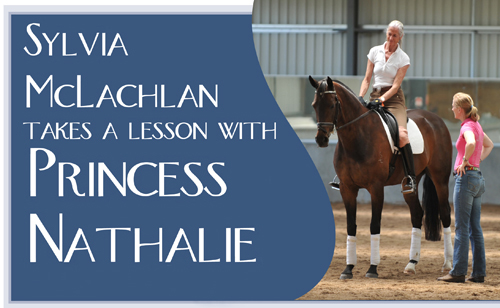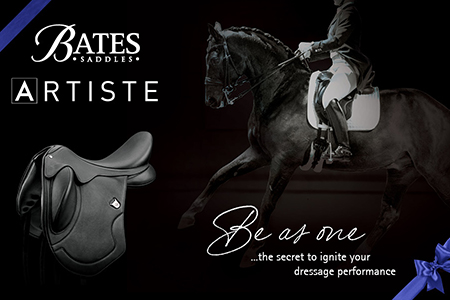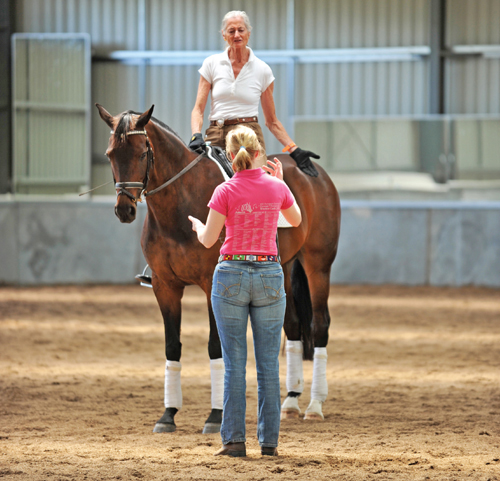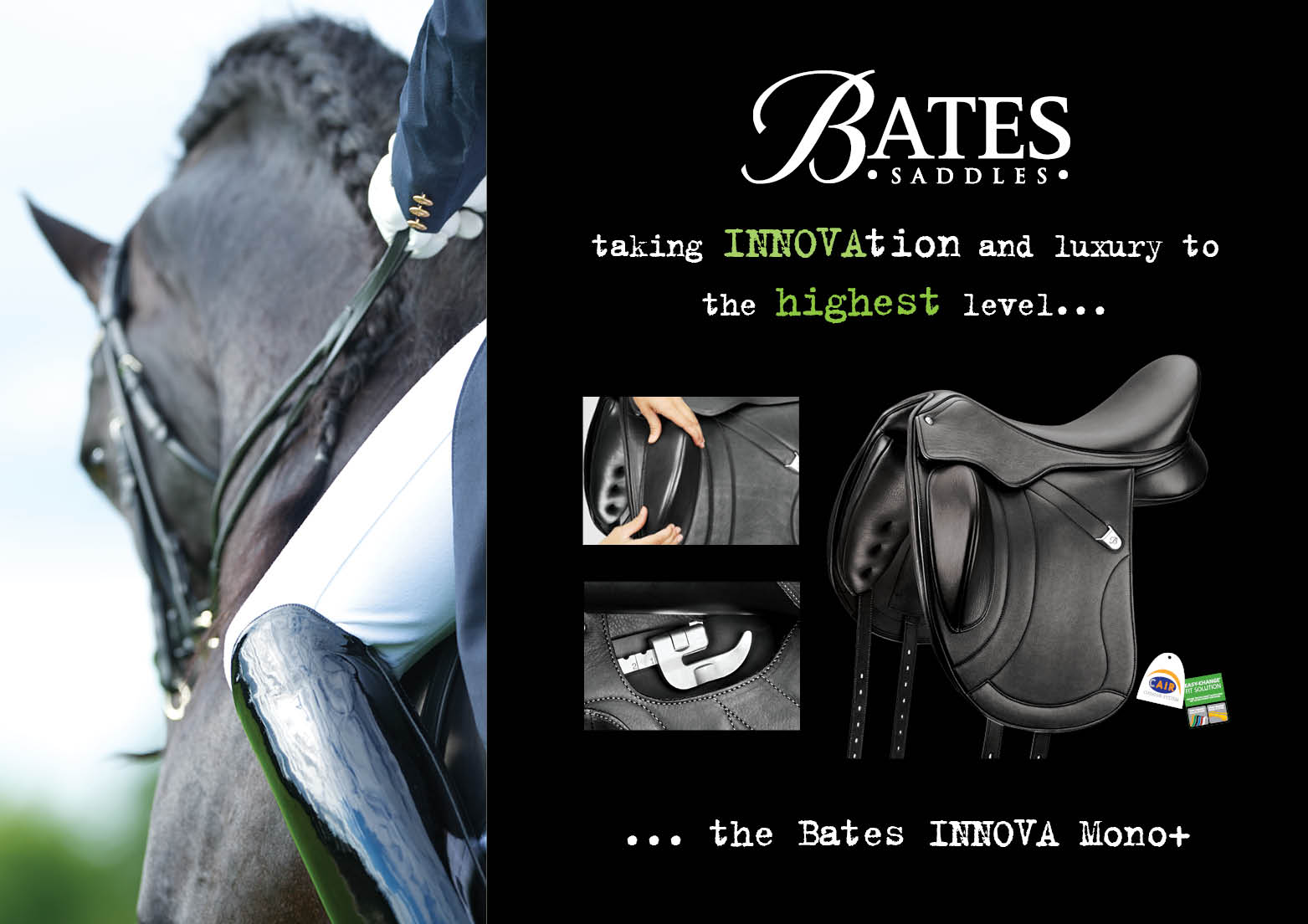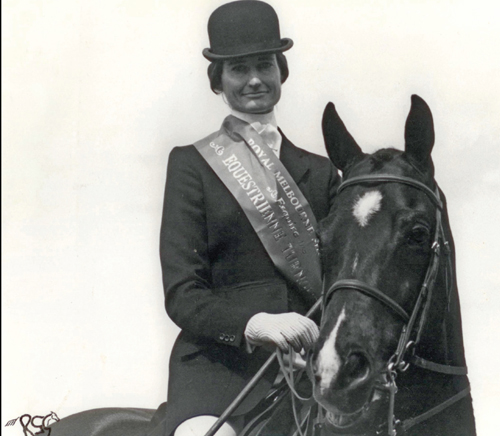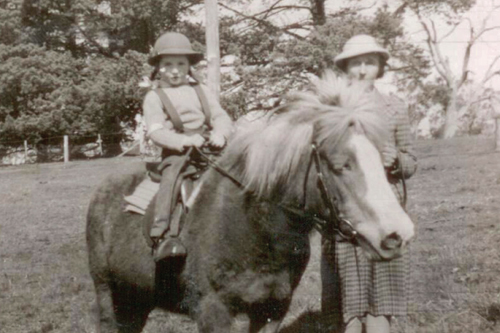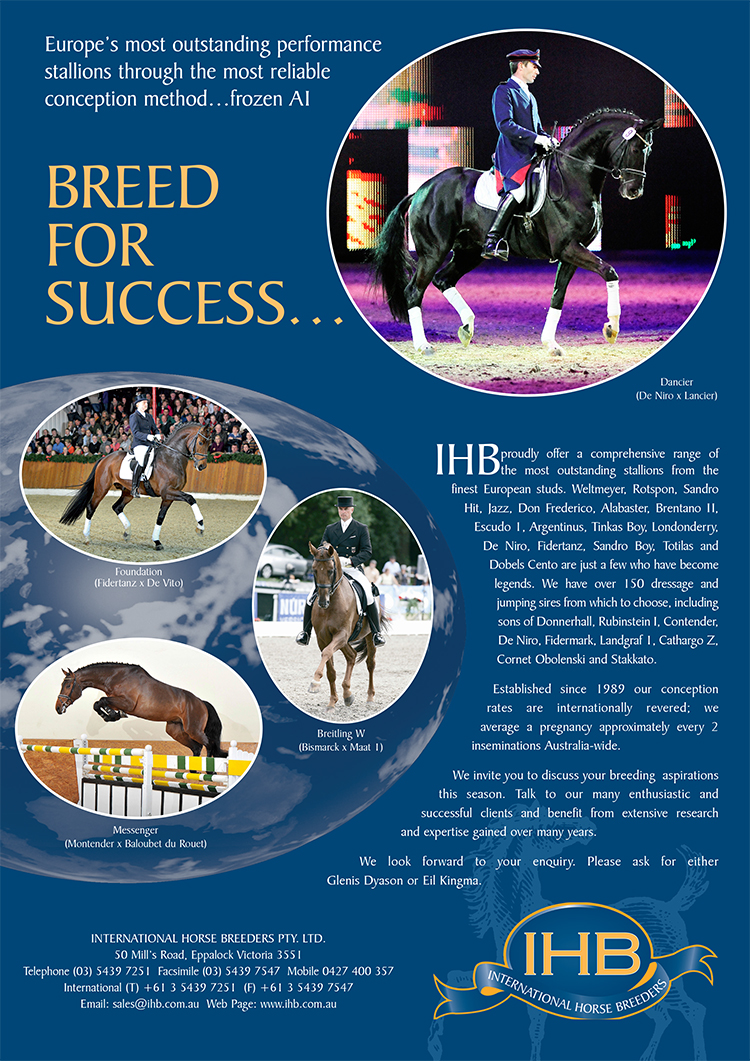It’s one of those concepts that is hard to explain in words… ‘connected’, ‘through’, ‘engaged’. Yes, we know the words, but the reality is a touch more elusive – but when you see it in action, the difference is oh so easy to grasp.
So it was over the course of a couple of lessons that visiting Danish dressage star, Princess Nathalie, gave to Australian dressage rider, Sylvia McLachlan on her home-bred mare, Mayflower.
It is all about contact; a concept so difficult to grasp that there is a school of dressage aficionados who just give up the battle and insist that you can’t do it, can’t push into the rein, this is a clash of aids that will ruin the horse. How wrong they are… It does take a subtle rider to achieve the result – contact not restraint.
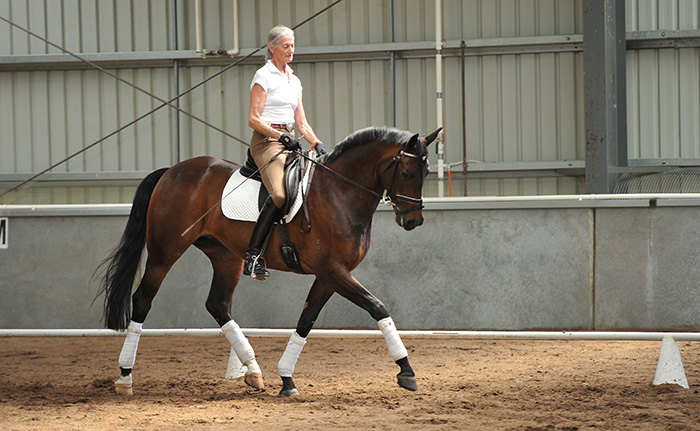
“Soft with your hands Sylvia, the mare has to feel that the hind legs come underneath her, and not that she is trapped. With the half-halt, she really has to step into your hand.”
Sylvia is pleased that Nathalie has seen how much work she has put in with the mare since their last clinic.
“You’ve kicked her arse, you’re more determined, you really want to have her through. Last time she was like this after the lessons, this time she is starting out where she finished.”
Ask, but ask with delicacy…
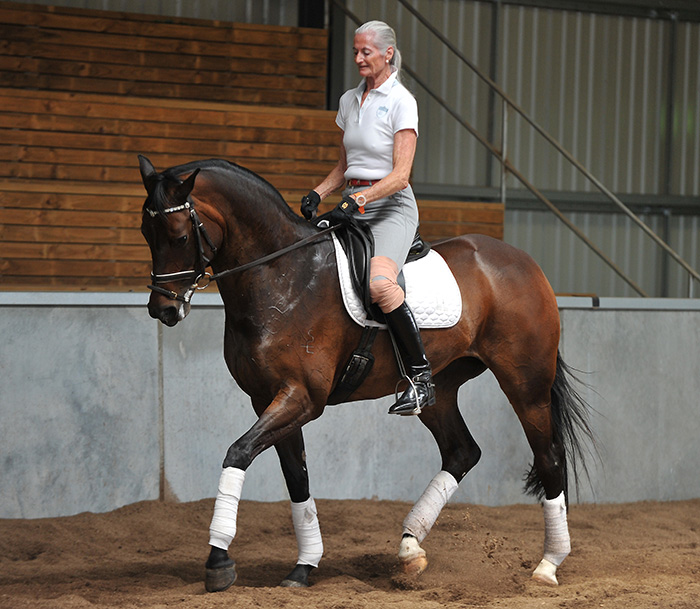
“Move your fingers, play a little with the rein, but don’t throw the rein away, she has to step into your soft hand. Bend her to the inside, sit on her hind leg, keep pushing the hind legs into your hand – not that you make a half-halt and she stops stepping with the hind leg.”
Sylvia is riding a shoulder-in on the left rein, working on increasing that connection.
“Half-halt, into the right rein, but ride the left hind leg into the right rein. Don’t let her run away. She has to accept and come into your hand, not wait until you give it away. She has to give on the rein, she has to stay short in the connection and stay in front of you…”
And suddenly the horse starts to look ‘European’. It is a quality of forward that you just don’t see all that often. Forward and into the rein is so different from just forward. There is a crispness, a freshness of the movement. But it is not all plain sailing, the mare has a hissy fit, she says she is happy to go forward but Sylvia has to give the rein away first, she is not amused with this forward and connected caper, I think I can hear the mare muttering, “leg without hand, hand without leg”, but luckily for Sylvia, Nathalie is there to help her ride through the resistance.
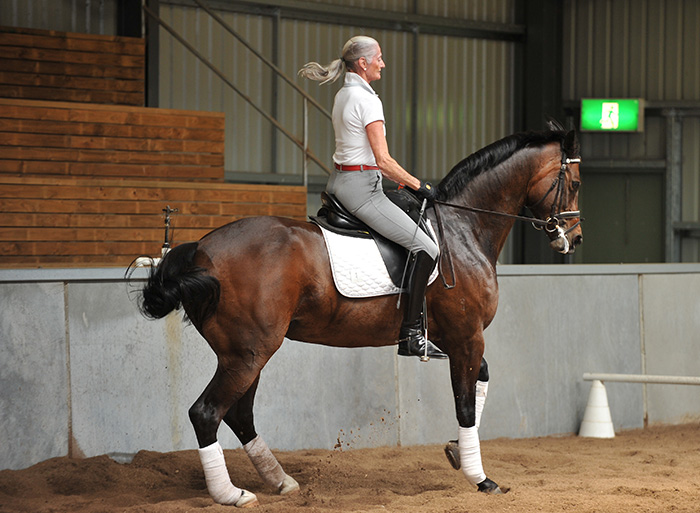
“It’s not about pulling back. Think of side reins – she has to step into the side reins, the side reins are elastic but they have a certain length. Have soft hands, but be determined that she steps through.”
And guess what? The mare does.
Over lunch I talked with Nathalie about her lesson with Sylvia:
It really is a totally different quality of movement when the movement is forward with connection, and it’s a quality of movement that we’ve seldom seen in Australia. We either see backwards, going forward without a connection, or boring into the bridle why is it so hard?
“Pffft. Why is it so hard? I think it’s that you have to know what you’re doing. And if you learn it in a wrong way or you don’t learn it from the beginning it is difficult to get adjusted to it. If you don’t have any anybody standing there every day saying the same thing for maybe a year, then it’s hard to do it in the right way, when you once have learnt it in the wrong way.”
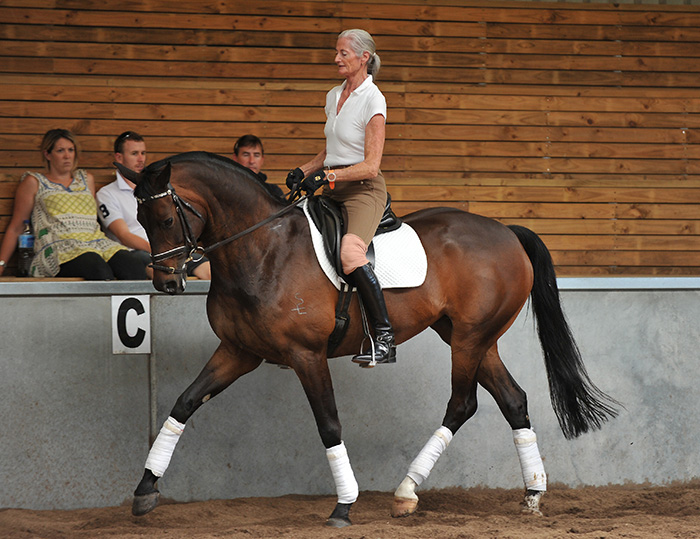
And also it’s a little scary isn’t it, we saw it with Sylvia’s mare, she is a sweet thing, but they do get excited, they do start to run backwards and bounce up and down…
“You know I think it’s something we all face at some point, I think it’s also in the education of the horse. A horse is not born to be evil, but they do try to find tricks and ways to get out of things that are maybe a little bit difficult for them. I think we all face it at some stage, but the really good riders, they know when it’s happening and they know that maybe it’s a phase they’re going through, but then they work through it. But if you’re not so experienced it’s tricky not to get stuck in that, and then you think, ‘Oh god, I don’t want that problem to happen again, I won’t go there anymore.’ That’s the tricky thing.”
So you have to know when you’re working through a problem or whether you’re frying the horse’s brain terminally…
“Exactly. That’s what I think.”
And how do you tell whether it’s terminal brain fry or positive?
“What happened with Sylvia is not a brain fry at all. If you really get stuck, if it happens every day and again and again and it happens for 20 minutes and you can’t get out of it, then that might be a problem. But like Sylvia here, the mare got a little bit ‘I don’t want to do this’, then she got out of the problem. That’s when you’re working through problems.”
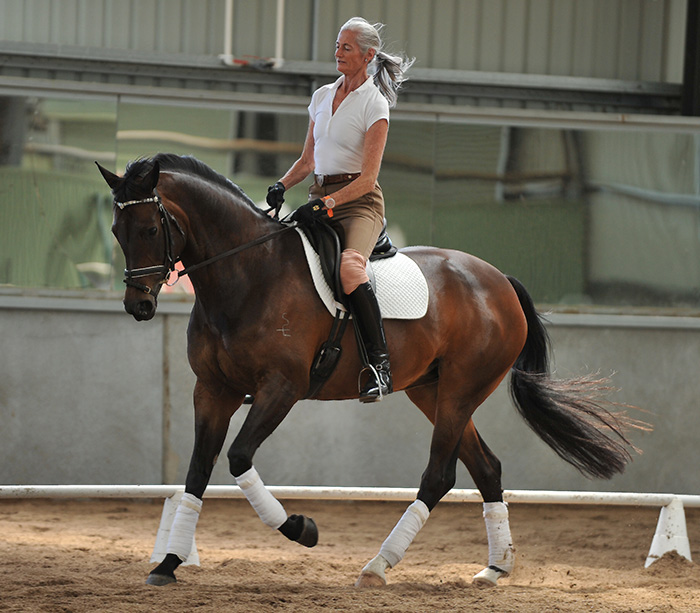
That’s the test, that you’re getting something good out of the resistance?
“Exactly. You will get some sort of resistance out of the education of the horse, but you have to work through it. I mean, the really good riders, the experienced riders, they get through it quite fast, the ones who are not so experienced, they can get stuck and they need professional help to get through it again.”
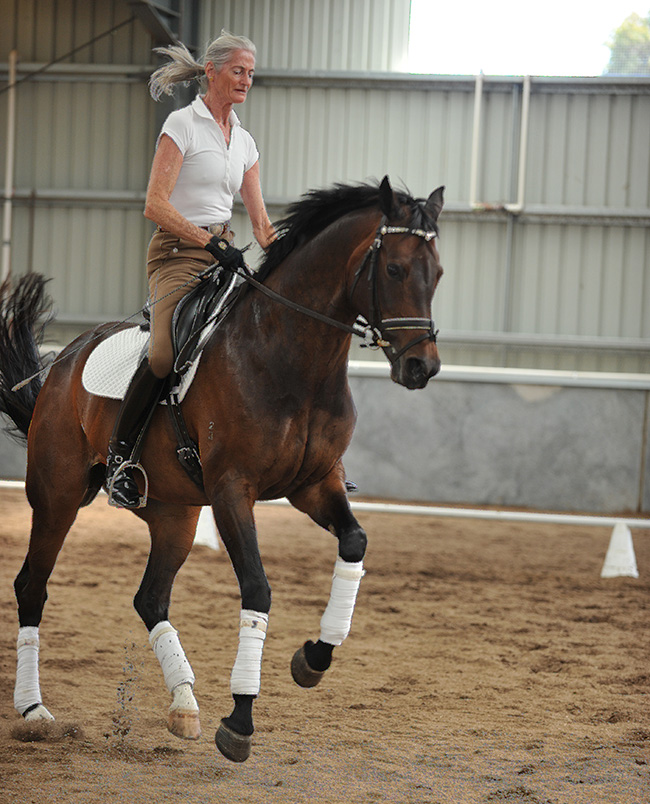
I was interested, Sylvia was saying, that until she came to this clinic that she hadn’t really understood the half-halt. And she was saying that you said to her, ‘no bring it up into your belly’ and she said ‘oh, I always thought it went down through my foot’, could you talk about that a little…
“That’s also something I’ve experienced, since I’m back working with Kyra Kyrklund and Richard White again, sometimes you just need other words to put to it, so it actually says ‘click’ in your mind, so you really feel ‘ah, this is how a half-halt should feel!’ It is more that a half-halt should be that the horse collects more, and comes up through the back to be able to use the hind legs stepping underneath it and to push forward. If the horse comes back and just pushes the back away, then you have the feel that the horse is getting smaller, how on earth then is it really going to go up through the back and forward.”
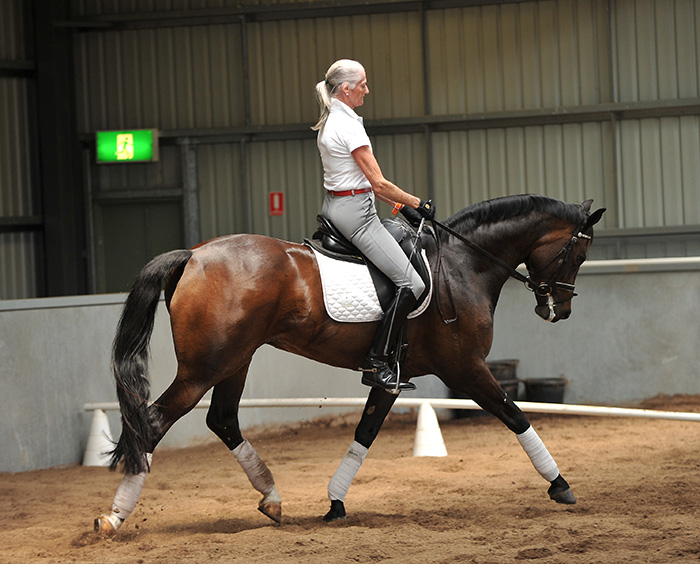
The movement of your body is an upward movement rather than a downward movement?
“Definitely, I always think that with every half-halt I want to have the feeling as if I am ‘lifting’ the belly up underneath me, to bring me up and then I can push it forward.”
Not pushing down through your stirrup?
“No. Definitely not. But, I mean other people will maybe explain it in a different way, this is how Richard tried to explain it to me, and how it said in my brain – ‘click’.
The session with Sylvia and the mare became a really positive lesson didn’t it?
“Yes, I’m really pleased how the mare has gone, because we had problems, she wasn’t quite through the last time I was here, but then I got on her yesterday and tried to fix a little bit, and made her understand what it was that I really wanted her to do. And I think with two days we really got her more through than we’ve ever had her. Maybe I should stay another week…”
Sylvia McLachlan – Horsewoman
I guess one of the reasons Sylvia McLachlan was able to respond so readily to Nathalie’s message is because she is no ‘dolly’ rider, she is a horsewoman who has paid her dues in just about every equestrian discipline. And it started early:
“I was very lucky. I started off riding when I was about two, riding around the cattle with my father. I grew up at Dunkeld. I’ve actually got a little grand-daughter now who is four, and I am sure I was rising the trot when I was four. She’s very keen, but she only comes down and visits me occasionally from Melbourne. I did miles. I was on a lead rope behind an old grey horse of dad’s, called Squirrel and Squirrel kept flicking me in the face with his tail to get rid of the flies. I was too scared to say anything – it was not a lot of fun.”
“I went home one day and said to Mum, Dad’s horse flicks me in the face all the time, and she said, for heavens sake – so from then on in, Dad plaited up Squirrel’s tail like a polo pony. Dad used to love going around looking at his bullocks, round and round we went. I’d had to, go back, trot on, go back, trot on. The first pony I had always pig-rooted, about every twenty feet, and I just thought that was natural for canter.”
“I did Pony Club. We were really lucky, Western District: John Kelly, Bill Roycroft, Ernie Barker, all of those fabulous people who just did things naturally. I grew up with a brother and a sister, eventing. I started eventing and had a couple of fabulous event horses. When I had the second baby I gave up eventing because I thought it would be easier. I got a horse called Cobb and Co, and went hacking.”
“Cobb and Co was a great horse, I ended up riding in the Samsung Cup with him – Prix St Georges level. I wish I had him now because he was a fabulous horse, and I didn’t really know what I was doing.”
“I played a bit of polo with the boys. I played in two Ladies Tournaments, and won both of them, and thought, I’ll rest on my laurels there.”
“But dressage became the main thing, and I just wish that we’d known more about dressage when I was younger. The ones now who are riding at the age of nineteen, are so lucky to have people like Nathalie helping them. I guess we were lucky in a way, in that we learnt to sit on a horse but we didn’t know any technique – I think at last I’m getting there – I think at the last clinic with Nathalie, I really learned how to do a half-halt…”
“At my age that is a bit of a tragedy to admit, but I really can now make a horse come up under me, whereas I used to just hope. I say that to my pupils, you are just hoping that the horse will do it. It’s an interesting thing. I think a lot of people try to make it all look nice, and they actually hope. Nathalie said to me at the last clinic, you make the half-halt up into your belt, I said, I thought you made it down through your foot. She said, no, no, no, because then you can’t kick them up. I got a bit of a result, but now I think I have mostly a real result, and my horse is going much better.”
Who was the first dressage coach?
“The first was Gwen Stead. She used to throw pinecones at me when I wasn’t going through a corner properly to make the bend. She used to come and stay with us, and when it was time for lunch, she’d say you girls ride on in front, I’ll catch up with you, and she’d have a swig of sherry. Mum would always give her a sherry anyway, but she’d have a little top up before she got to the house. She was very good, she went away with the team to Rome as a helper. I suppose we took in more than we thought from her.”
“Bill Roycroft taught me about eventing, riding lines and things, he was such an influence.”
“Then when I went to South Australia, Malcolm Barns used to come over and give lessons, again, another brilliant horseman, and a great teacher.”
“After that, one of the main influences was Christopher Bartle, and he got me really excited about dressage. Christopher used to come and give clinics in South Australia. I became good friends with him, and stayed with him in England, then he came and did several clinics at our place until he became coach of the German Eventing team. We had great fun, he had a hit on the boys’ polo ponies. I’m very fond of Christopher, and he is an amazing horseman. Not many people have won Badminton, been round Aintree, and placed in Grand Prix dressage at the Olympics.”
“His wife Alison, helped me look at horses over in Germany. We had one very funny experience together – we went to one very smart indoor arena. The horse looked a bit like it had wheels in its head. They obviously thought we knew nothing – which is funny because Alison helps bring on all Christopher’s young horses, and she has a fabulous eye. They must have thought we were a pair of doozies, the owner’s wife said that the horse was good for me because its colour suited me! They wanted a horrendous price for this horse, and it practically needed a twitch for you to get on it. Afterwards, I ran my hands down its back legs and it had great big trailers on its hind shoes. I said ‘Why do you have these on?’ ‘We put them on all our good horses, it saves their ligaments’ – ‘funny at home we only use them for Navicular!’ That stood them up a bit.”
You’d always ridden Thoroughbred horses, when did you go to the Warmbloods?
“The first was Cossack who was by the Trakehner, Kaliber. He was a fabulous horse. He’s another I wish I had now, because I could have done a job on him now. He was the first really big moving thing I had.”
Now you have an imported Warmblood, Avignon…
“I had great fun looking for him. I saw some lovely horses in Denmark, then we went to Germany. I went to Holga Finken’s stable to look at a Don Schufro who was beautiful in the wash bay… we saw Avignon working by chance, he had only come from Austria for a week with a showjumping rider. I sort of fell in love with him like you fall in love with a man and I still have that feeling to today. I had a super Irishman working for me, and he said, you know this horse looks out for you every morning until you get here. I could put my little grand-daughter into the stable with him, all night, and not worry. He is a fabulous horse.”
You’ve still got quite a few…
“I’ve got a Trak up with Tor van den Berge at the moment, he is a lovely big horse, 17.2hh, he actually pelted me about 18 months ago, but I am going up to have a sit on him because Tor says he is pretty good now. I’ve got a lovely Thoroughbred of Sybil Bailleu’s, which is about to go Medium, very lovely light horse – the good Thoroughbreds are still good. And I’ve got Mayfly, my Gymnastic Star mare, out of a Thoroughbred I owned. I also bred a Jazz out of one of my mares – the Jazzes are not your normal cup of tea, but I think he is going to be a really nice horse, he’s just a bit looky. He has a wonderful canter, but I am not sure I’ll take him to the Young Horse classes at Dressage with the Stars because sometimes I think it doesn’t really help bringing them out young. We all used to think that we had to take them there but at the end of the road, it is not the young horse classes you want to win.”
What is it that keeps the dressage fascination happening…?
“I think when you really get them, it makes you feel like a princess, when the horse is really through and really sitting. My husband used to always say, I can always tell how your horses went by what sort of a mood you are in… Mary Hanna says, it doesn’t take too much to make my day, and she is right; when you have a seriously good ride and they are sweet and forward. I’m not a very good dancer, but if you dance with someone really wonderful, it’s a pretty good feeling. I think that is what keeps you going. Some mornings, I think I’d rather potter around in the garden and not go up to the stables, why couldn’t I just be normal… go out to lunch. Then I go on holidays for two weeks and by the end I am really looking forward to getting home to the horses again…”
Story by Chris Hector & Photos by Roz Neave

